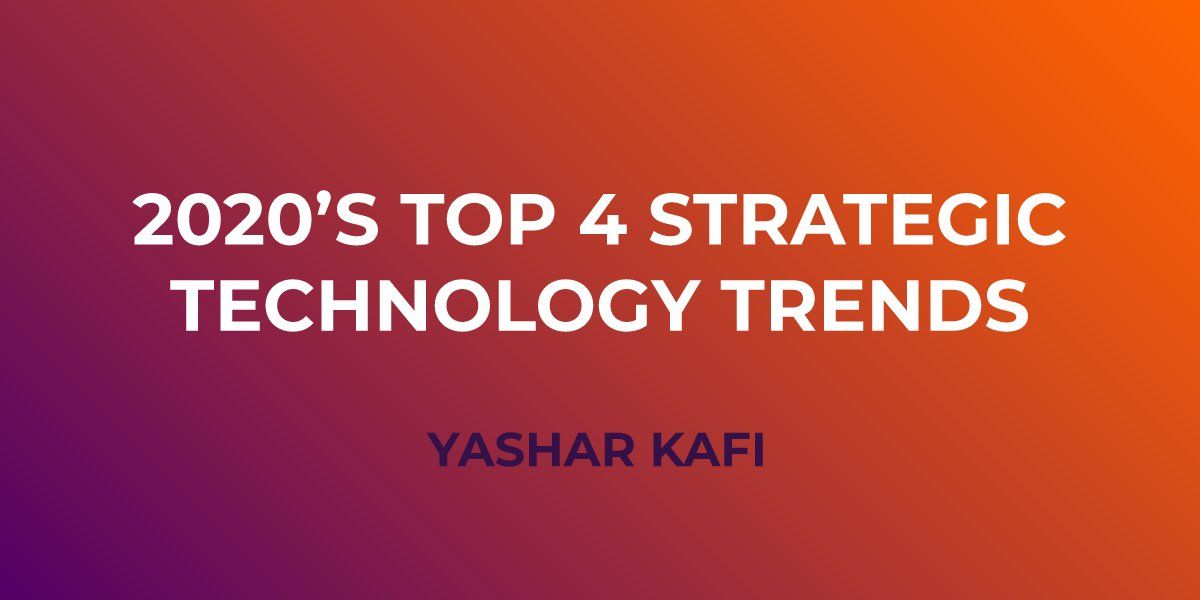2020’s Top 4 Strategic Technology Trends
The year 2020 is undoubtedly the prelude to another decade that will bring immense technological advancement and enhancement to the workplace, home, and society around us. There will be disruption everywhere as new trends take over, and the tech further streamlines random aspects of life. Many of the technologies that will affect this decade are already implemented and, in many cases, commonplace across industries. But we should observe the proliferation of new use cases and applications that present both benefits and new opportunities for the companies that use them.
So let’s take a look at four of the most highly anticipated changes on the not-so-distant horizon.
Automation 20s: Hyperautomation
Hyperautomation takes the advancements in automation across the past two decades and amplifies their capabilities. It’s the application of robotic process automation (RPA), artificial intelligence (AI), and machine learning (ML), alongside the analytical discipline of process mining to augment employees and further automate processes in far more impactful and superior ways to traditional automation techniques. One of the major advantages of hyperautomation is its ability to discover, analyze, design, automate, measure, monitor, and reassess workflows, tools, and systems in the manner that a human would, removing the need for staff to manage the stations.
Democratization
The democratization of technology has already been a key player in the last five years, simplifying the increasingly advanced systems so that almost anybody can use them without expertise. Sometimes this is referred to as providing “citizen access,” and it focuses on four key aspects of software and applications: application development, data and analytics, design, and knowledge.
Across this decade, we’re likely to see a huge rise in “citizen” data analysts, programmers, and creators of applications and software. This will primarily be driven by computer experts creating systems that thrive on AI-driven and generated coding, which will automate the tougher parts of the coding process.
An excellent example of democratization already existing is the ability to create a website within an hour through services like Wix and WordPress. A user can essentially “make it pretty” by choosing the website’s user interfaces and surface-spaces without having to do any actual coding. This means they need no expertise—just some cash in the bank to pay for the subscriptions.
The Distributed Cloud
Heard of the cloud? The metaphysical data storage center where all of your documents, photographs, and everything else tech-related is stored? Well, this decade should see the distributed cloud take over the show. The distributed cloud is the dispersal of public cloud services to places external of the cloud provider’s physical servers. The provider will still be in control, though, and they’ll be responsible for every aspect of their system, including the maintenance, operations, security, delivery, and architecture.
This will make a huge difference to the standard centralized cloud, allowing data centers to be placed anywhere in the world, which will allow hosts to easily solve technical and regulatory issues like data sovereignty.
Artificial Intelligence and Security
Through ever-evolving technologies, the world gets smarter and more capable every day that passes. But with the advancement in tech comes a host of problems, namely, security vulnerabilities that can be exploited maliciously. That’s where AI and machine learning, augmented with human capabilities, will come into their own, making a huge impact on the security sector.
The future of AI security will have three key focuses: first, protecting AI-powered systems, while simultaneously securing AI training data, training pipelines, and machine learning models for future prevention; second, leveraging AI to enhance security defense, and deploying machine learning systems to understand the complex patterns, uncover attacks, and turn parts of the cybersecurity process fully-automated. Third, AI security will be used to anticipate the potentially nefarious use of AI by attackers or hackers—figuring out where it could go wrong, and how to defend against any problems.
These are just four of the many expected technological advancements and enhancements that will come during the ’20s. Assuming the world continues to spin on its axis and everybody remains friendly, we’re heading into a decade of the workplace and homelife revolution: a decade where, if you’re not already onboard, your businesses will be forced toadopt and implement the new wave to tech, whether you like it or not.




